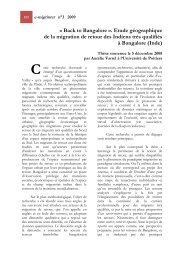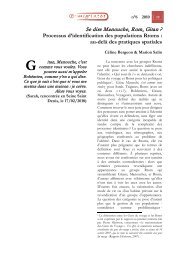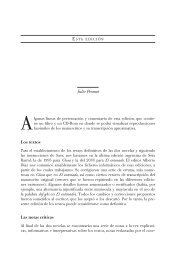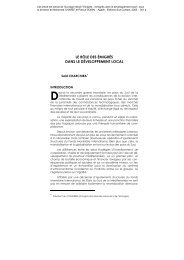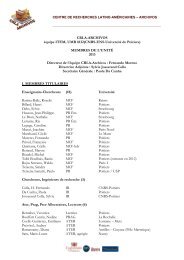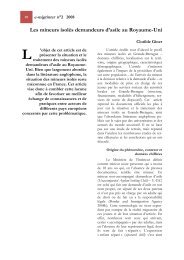e-migrinter 2010 numéro 05 - Maison des Sciences de l'Homme et ...
e-migrinter 2010 numéro 05 - Maison des Sciences de l'Homme et ...
e-migrinter 2010 numéro 05 - Maison des Sciences de l'Homme et ...
You also want an ePaper? Increase the reach of your titles
YUMPU automatically turns print PDFs into web optimized ePapers that Google loves.
26 n°5 <strong>2010</strong><br />
is, however, how “homogenous” or how<br />
“different” the pupils have to be (Gullestad,<br />
2001, 2002 : 19, 79ff), in which situations<br />
they have to be “homogenous” or<br />
“different”, who <strong>de</strong>ci<strong><strong>de</strong>s</strong> what is<br />
“homogenous” and what is “different”, and<br />
who <strong>de</strong>ci<strong><strong>de</strong>s</strong> the contexts. The school class<br />
system have a lot of implicit and explicit<br />
cultural rules for behavior which makes<br />
integration of minority pupils in schools a<br />
complicated and long process. Some of the<br />
implicit rules cannot be explicitated and are<br />
therefore difficult to discover for outsi<strong>de</strong>rs<br />
(An<strong>de</strong>rson, 2000 : 236, 253f). The minority<br />
pupils do not only have to learn the majority<br />
language – Norwegian in this case – but they<br />
also have to learn to use it in all situations,<br />
and they need to learn the explicit and<br />
implicit co<strong><strong>de</strong>s</strong>, norms and rules for playing<br />
and behavior.<br />
The i<strong>de</strong>ology of likeness<br />
The i<strong>de</strong>a of likeness is wi<strong><strong>de</strong>s</strong>pread, at<br />
least in Scandinavia, and is important for the<br />
national self-un<strong>de</strong>rstanding for many people.<br />
The term “likeness” has many meanings, the<br />
most common is to divi<strong>de</strong> b<strong>et</strong>ween<br />
“equality” and “homogeneousness”<br />
(Gullestad, 2001 : 35, 2002 : 68f).<br />
Homogeneousness involves for instance<br />
being similar as human beings, to look alike ;<br />
ignore differences ; or wearing the same<br />
dress. Equality implies amongst other things<br />
that everyone has the same opportunities<br />
and possibilities for example to be different,<br />
and it contains social equalization and<br />
“result-likeness” where the weakest are<br />
compensated. The i<strong>de</strong>al of likeness involves<br />
that one has to feel homogeneous to<br />
“everybody else” to “fit” tog<strong>et</strong>her<br />
(Gullestad, 2002 : 68f, 82 ; Seeberg, 2003 :<br />
25ff). Seeberg means that in Norway,<br />
likeness is a necessary starting point for<br />
interaction b<strong>et</strong>ween people (Seeberg, 2003 :<br />
27, 186). In the same time, it’s important to<br />
remember that there’s nothing which is<br />
absolutely homogeneous or absolutely<br />
different, this is som<strong>et</strong>hing which is<br />
culturally <strong>de</strong>ci<strong>de</strong>d and usually it’s the<br />
majority population who has the power of<br />
<strong>de</strong>ciding what is homogeneous and what is<br />
different.<br />
The i<strong>de</strong>ology of likeness entails that<br />
what people have in common will be<br />
emphasized while the differences, the social<br />
bor<strong>de</strong>rs, will be <strong>de</strong>-emphasized. Only when a<br />
<strong>de</strong>finition of the situation is established, the<br />
differences will be taken out for the<br />
individual to “confirm herself” (Gullestad,<br />
2001 : 35ff ; 2002 : 82ff ; Barth, 1998). This<br />
implies that one sees different social groups<br />
as “the others”, as different or as “strangers”<br />
in relation to oneself (Barth, 1998 : 15). In<br />
the same time i<strong>de</strong>ntification of “others” is an<br />
important element in establishing one’s own<br />
i<strong>de</strong>ntity (Eriksen, 2002 : 89). Generally<br />
speaking one can say that social i<strong>de</strong>ntity is<br />
most important at the moment were it seems<br />
threatened (Eriksen, 2002 : 68). Gullestad’s<br />
term “bor<strong>de</strong>rs of likeness” is central in this<br />
case, because the term inclu<strong><strong>de</strong>s</strong> the<br />
distinctions and power-balance that the<br />
<strong>de</strong>mands of likeness often require and<br />
maintains (Gullestad, 2002 : 84). Differences<br />
are often perceived as problems but<br />
paradoxically they are created in or<strong>de</strong>r to<br />
strengthen the likeness and the<br />
belongingness insi<strong>de</strong> a group (id. ibid.).<br />
One step further from Gullestad’s<br />
“bor<strong>de</strong>rs of likeness” is Eriksen’s “paradox<br />
of multiculturalism” (Eriksen, 2002 : 144f).<br />
Eriksen means that on the one hand the<br />
majority population says that the minority<br />
has to become homogenous with the<br />
majority in or<strong>de</strong>r to take part in the soci<strong>et</strong>y,<br />
and on the other hand it says : No matter how<br />
much like us you are, you will remain apart<br />
(Eriksen, 2002 : 144 ; Gullestad, 2002 : 102f ;<br />
Thors<strong>et</strong>h, 1995). The first is a matter of<br />
assimilation hid<strong>de</strong>n by the i<strong>de</strong>ology of<br />
likeness, the latter is a question of<br />
segregation. This shows that the differences,<br />
which according to the “bor<strong>de</strong>rs of likeness”<br />
are nee<strong>de</strong>d for likeness to exist, really exist.



